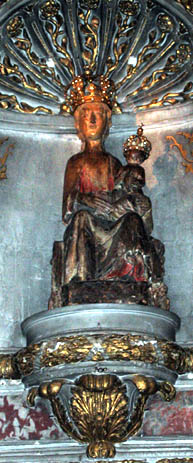 July 31
July 31
Notre-Dame de Verdelais, Verdelais, Gironde, Nouvelle-Aquitaine, France
In 1099, during the First Crusade, Géraud de Graves was riding toward Bethlehem with some 60 knights, when they suddenly confronted a force of 1500 Muslims. As his men began to flee, de Graves prayed to the Virgin, promising to build her a chapel if he won the contest. He ordered his reluctant crusaders to turn and face their astonished foes. The rout succeeded.
Three years later de Graves returned to Aquitaine with a statue of the Virgin and built a chapel for "Our Lady of Luke" near the forest hermitage where he stayed until his death in 1159. Such was the story perpetuated by the next owners of the property, the monks of Grandmont, whose sanctuary to the Virgin became an object of pilgrimage after a blind youth gained sight in 1185. Gill Evan (verdelais.blogspot.com, 2005) suggests de Graves had the statue carved in Bethlehem and that the name Luc derived from the old name of the territory near Verdelais, but possibly that name came about because the statue's devotees believed it to be an original work by St. Luke or a copy of such a work from the Holy Land.
During the Hundred Year's War and the Anglo-French war of 1294-1303 preceding it, the monastery and chapel were destroyed. Then in 1390, when Countess Isabelle de Foix asked for a sign as to where she should build a church in thanksgiving for her sons, her mule stumbled on a stone. It turned out to be hiding a buried statue of the Virgin and Child, believed to be Our Lady of Luke, hidden from the English in 1295.
During the French Revolution, the sanctuary was again destroyed but the statue saved. After the return of monarchy, Marist Fathers rebuilt the church, which was rededicated July 31, 1824 to the Nativity of the Holy Virgin. On June 2, 1856, the statue was solemnly crowned. On February 1, 1924, the Pope made the church a Minor Basilica, an honor celebrated grandly on July 31 of that year.
The polychrome statue of chinquapin wood has been dated to around 1300, so while it may well be the one the Countess de Foix uncovered, it could not have come from the Holy Land in 1102 or presided over a healing in 1185. The original was probably destroyed along with the monastery in 1270 and another substituted. (Picture from "verdelais," Département Landes - Foi et Spiritualité Chrétienne, pagesperso-orange.fr.)
An annual pilgrimage to Our Lady of Verdelais takes place on the second Sunday after Easter.
Also commemorated this date:
| Virgen de la Consolación, Huachana, Santiago del Estero, Alberdi, Argentina. Fiesta, pilgrimage to mountain shrine where image appeared in 1820. | |
| Nostra Signora della Salute, Turin, Italy (Our Lady of Health). Statue blessed, 1887. |